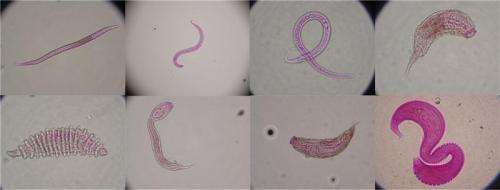Microscopic view of nematodes. Credit: Cristina Gambi, Marche Polytechnic University
A research team with members from Spain, Argentina and Italy has found that intense deep sea trawling cuts seafloor biodiversity in half. In their paper published in Proceedings of the National Academy of Sciences, the team reports on what they found in sediments taken from heavily trawled areas compared with seafloor areas that have not been trawled at all.
Over the past several decades, fish populations near shore have been severely reduced, forcing fishermen who wish to stay in business, to move farther out to sea. Those who catch fish using nets dragged along the seabed (trawling) now routinely trawl at depths up to 650 feet below the surface. Worse, they repeatedly trawl the same areas over and over until no more fish can be had, before moving on to a new spot. This, the researchers with the study, report, is not only reducing fish populations, but is also reducing the populations of all types of fauna that live on or near the seafloor.
To better understand the impact of modern deep sea trawling, which includes repeated trawling over the same parts of the ocean, the researchers obtained sediment samples off the coast of Spain in areas known to be heavily trawled, with sediment samples taken from a sea canyon that had not been trawled and then compared the two for differences. They found that the heavily trawled area had 50 percent less biodiversity than the pristine area, which included 80 percent fewer sea worms. They also found that there was 52 percent less organic matter, and 32 percent slower carbon consumption. This they claim, suggests that daily carbon deposited onto the seafloor and removed by trawling may be as high as 60 to 100 percent, which of course, is unsustainable. The researchers liken it to the problem of soil erosion on lands that are over farmed.
The researchers point out that their findings suggest that the continuation of intensive deep sea trawling represents a major threat to the biodiversity of the ocean sea floor and is likely to result in serious environment effects, one of which would presumably be a serious reduction in fish populations.
More information: Pusceddu, A., Bianchelli, S., Martín, J., Puig, P., Palanques, A., Masqué, P., Danovaro, R. (2014) Chronic and intensive bottom trawling impairs deep-sea biodiversity and ecosystem functioning. Proceedings of the National Academy of Sciences, www.pnas.org/content/early/2014/05/14/1405454111
Abstract
Bottom trawling has many impacts on marine ecosystems, including seafood stock impoverishment, benthos mortality, and sediment resuspension. Historical records of this fishing practice date back to the mid-1300s. Trawling became a widespread practice in the late 19th century, and it is now progressively expanding to greater depths, with the concerns about its sustainability that emerged during the first half of the 20th century now increasing. We show here that compared with untrawled areas, chronically trawled sediments along the continental slope of the north-western Mediterranean Sea are characterized by significant decreases in organic matter content (up to 52%), slower organic carbon turnover (ca. 37%), and reduced meiofauna abundance (80%), biodiversity (50%), and nematode species richness (25%). We estimate that the organic carbon removed daily by trawling in the region under scrutiny represents as much as 60–100% of the input flux. We anticipate that such an impact is causing the degradation of deep-sea sedimentary habitats and an infaunal depauperation. With deep-sea trawling currently conducted along most continental margins, we conclude that trawling represents a major threat to the deep seafloor ecosystem at the global scale.
Journal information: Proceedings of the National Academy of Sciences
© 2014 Phys.org























